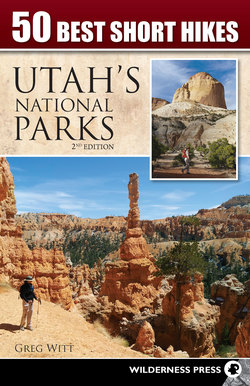Читать книгу 50 Best Short Hikes in Utah's National Parks - Greg Witt - Страница 10
На сайте Литреса книга снята с продажи.
ОглавлениеINTRODUCTION
When was the last time you strapped on a pair of boots and let out a jaw-dropping “WOW”? If you can’t remember, then it’s been way too long.
But where are the guaranteed wow-producing hiking trails? Right here, in Utah’s five national parks.
Within these pages you’ll find trail descriptions and precise directions for dozens of the best day hikes in what I think is the most beautiful, fascinating, and diverse topography in the world—Arches, Bryce Canyon, Canyonlands, Capitol Reef, and Zion National Parks.
This book’s title, 50 Best Short Hikes: Utah’s National Parks, has two operative words in the title: best and short. What you’re about to uncover represents the very best of the thousands of miles of hiking trails within Utah’s national parks. Many of these hikes are not only national treasures but are also rightly considered to be some of the best hikes in the world—Queens Garden, Delicate Arch, and Angels Landing certainly achieve that level of distinction. By short we mean day hikes of less than 8 miles, so enjoying two or even three of these hikes in a single day is doable.
This book was written as a trip-planning resource with families, casual hikers, and out-of-state visitors in mind, so that they can obtain maximum enjoyment from what might be a once-in-a-lifetime trip to Utah. Nevertheless, if you’re an avid hiker and you live nearby, I can assure you that you’ll still be amply rewarded by the hike descriptions and supplemental material provided herein.
Once you arrive at one of the parks, you’ll want more than a drive-by experience. You’ll be looking for family-friendly, easy-to-manage trails with bragging rights and photo ops included. All of these trails are hiker-tested, measured, and mapped.
Don’t worry about running out of breathtaking scenery to explore. It will take you years to travel all these trails and unravel their mysteries. Petrified sand dunes, slot canyons, hoodoos (rock columns), and brilliant sandstone will fascinate you at every turn in the trail. Prairie dogs, prickly cacti, trickling springs, and star-studded skies will add even more to your adventure.
Each Utah national park has a distinct personality, profile, and palette. The more trails you try, the more you will understand why these areas are protected as national parks. Towering cliffs of brilliant orange, deep rust, mustard yellow, chocolate brown, creamy white, and muted green create an ever-shifting scenery above you and underfoot. The colors change even further with the help of clouds, rain, snow, or the setting sun.
In spite of their topographic differences, a single powerful force has shaped all five desert treasures: erosion. Eons of water, ice, and wind have created a kaleidoscope of geological features with Mother Nature’s recipes. Each trail has been selected to help you see these geologic features up close.
I’ve tromped down every one of these trails, and dozens more, to identify the very best for you. Nature demands patience and curiosity to get the most from an outdoor experience. With 50 Best Short Hikes: Utah’s National Parks, you’ll find what you’re looking for—and so much more.
DRIVING IN THE NATIONAL PARKS
Most of the trailheads within this book, which are mainly front-country trails, are on paved and widely traveled roads in the more popular and widely accessed areas of the parks. But some trails in this book are found at the end of rocky, rutted, and occasionally impassable dirt roads. Some of these notably remote hikes include Tower Arch, Horseshoe Canyon, Elephant Hill, Golden Throne, Grand Wash, and Cable Mountain.
If your planned hike takes you to a trailhead on a dirt road, check first with the park’s visitor center for current road conditions and a weather forecast. Recognize that even though a dirt road may be passable when you enter, conditions could change dramatically with rain or snow. Dirt roads in the desert could become muddy and slippery, and a flash flood could leave your return route washed out or strewn with rocks and debris.
If your trip involves one of the remote trailheads, always start the day with a full tank of gas and emergency provisions such as extra water, food, and clothing. Experienced desert travelers know that utility items in the trunk of the car, such as a shovel, towline, jack, and spare tire, can be lifesavers when your car is stuck or disabled.
HIKING SEASONS
Utah’s five national parks are open year-round, though the availability of some services, such as shuttles, visitor centers, ranger-led programs, and campgrounds, will vary by season and from one park to another. Most of the hikes in this book are accessible and hikeable year-round. Even Bryce Canyon, with its high elevations and snowpack, can be enjoyed in winter on cross-country skis or snowshoes. In the arid desert of southern Utah, spring and fall often offer some of the most favorable hiking conditions. Regardless of when you plan to visit, it’s important to plan carefully. National-park websites and visitor centers can provide planning information and weather forecasts, but your safety and enjoyment will depend on your own good judgment, preparation, and constant awareness.
PARK REGULATIONS
Visit nps.gov for additional rules.
Campfires are prohibited except in front-country campgrounds, and wood gathering is not allowed.
All vehicles, including mountain bikes, are restricted to designated vehicle routes; off-route travel is not permitted.
Pets are not allowed on hiking trails.
Hunting is prohibited.
Do not use soap in or near water sources.
Watch wildlife from a distance, and never feed wild animals.
Swimming in potholes is not allowed unless the pothole is continually recharged by flowing water.
The destruction, defacement, disturbance, or removal of natural or historical objects is prohibited.
